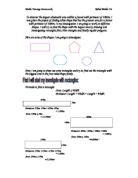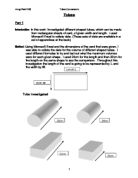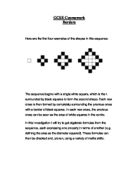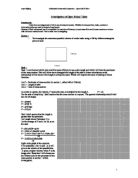The Tetrahedron.
THE TETRAHEDRON Figure 1 Let each side of the tetrahedron (in blue) = s. The tetrahedron has 6 sides, 4 faces and 4 vertices. Here the base is marked out in gray: the triangle ABC. From The Equilateral Triangle we know that: Area ABC = (\/¯3 / 4)s². Now we need to get the height of the tetra = ED. E |\ | \ | \ ----\ D A figure 2 From The Equilateral Triangle we know that: DA = (1 / \/¯3)s. Now that we have DA, we can find ED, the height of the tetrahedron. We will call that h. h² = ED = EA² - DA² = s² - (1/3)s² = (2/3)s² h = ED = (\/¯2 / \/¯3)s So V(tetra) = 1/3 * area ABC * height(tetra) = 1/3 * (\/¯3 / 4)s² * (\/¯2 / \/¯3)s, V(tetra) = (\/¯2 / 12) s³ = (1 / 6\/¯2 )s³ = 0.11785113s³ What is the surface area of the tetrahedron? It is just the sum of the areas of its 4 faces. We know from above that the area of a face is (\/¯3 / 4)s². So the total surface area of the tetrahedron = \/¯3 s². We have found the volume of the tetra in relation to it's side. Since all 4 vertices of the tetra will fit inside a sphere, what is the relationship of the side of the tetrahedron to the radius of the enclosing sphere? Also, where is the centroid (the center of mass) of the tetrahedron? It's easier to see the radius of the enclosing sphere if we place the tetrahedron inside a
The fencing problem 5-6 pages
The Fencing Problem - Mathematics A farmer has exactly 1000 meters of fencing, with it she wishes to fence off a plot of level land. She is not concerned about the shape of the plot, but it must have a perimeter of 1000m. She wishes to fence off a plot of land, which contains the maximum area. Part One Using rectangles; I will investigate how she may obtain a maximum plot of land, using rectangles with a perimeter of 1000m. I will do this by using calculations to find the area of each different possible perimeter situation. For the first part of the investigation, I will calculate some possible areas for the plot of land, making sure the perimeter is exactly 1000m. For my first examination, I will try quadrilaterals. Side 1: 100m Side 2: 400m Side 1: 200m Side 2: 300m Side 1: 250m Side 2: 250m Side 1: 450m Side2: 50m Side 1: 350m Side2: 150m Side 1 Side 2 Area 00 m 400 m 40000 m2 250 m 250 m 62500 m2 300 m 200 m 60000 m2 350 m 50 m 52500 m2 450 m 50 m 22500 m2 The graph and the table indicate that when the width and the height of the regular quadrilateral have the least difference, the Area seems to be at its greatest. The statement is proven by the square. A square has all the sides the same, so the difference is the smallest possible value since it is zero. The area of the square is the
A Settlement Enquiry
Contents page Page 2- Aim Hypothesis Introduction Method Page 3- Area of Study Page 4- Results Analysis Page 5- Results Analysis Page 6- Results Analysis Page 7- Results Analysis Page 8- Results Analysis Page 9- Results Analysis Page 10- Results Analysis Page 11- Conclusion Evaluation A Settlement Enquiry Aim- To investigate the perceived effects of the building and operation of Terminal 5 on the quality of life and standard of living of different people. This means we are going to find out how the building of Terminal 5 will affect all types of peoples life in the surrounding areas. Hypothesis- Terminal 5 will benefit all different groups of local people equally. This is a geographical theory of what the affects of Terminal 5 will be. This theory is saying that Terminal 5 will affect all people living in the surrounding area the same. The objective of my study is to figure out if the hypothesis is right or wrong, I am going to do this by going to Staines and Ashford and Shepperton surveying all the different types of people (Male, female, adult, child, pensioner, disabled, working class, Family) I am going to ask different questions to find out how terminal 5 affects each group of people and compare the results. I'm also going to find other geographical theories to see if they agree with the hypothesis. Method I collected my data by
Grassland Investigation-Does Light Affect The Distribution Of Daisies?
Grassland Investigation-Does Light Affect The Distribution Of Daisies? Planning Many different factors affect the distribution of plants, and many factors affect the population of animals in different areas. Physical factors and Biotic factors affect these. They can vary from differences in soil fertility, oxygen levels, pressure, temperature, disease, availability of food, colonization and migration. All these affect the level of plants and animals found in one particular area. In this test I am going to see if the level of sunlight affects the distribution of daisies and other plants found in that area. To do this I have found two almost identical areas of grassland within the boundaries of the school. One of these areas has an overhang from the trees next to it, meaning the grass is almost constantly shaded. The other area is very open and has all the advantages and disadvantages of open grassland. I have chosen these 2 areas because they are both flat, although certain parts of the area must not be included as they are sloped. I cannot make this experiment very accurate, as other factors will affect the distribution of daisies other than light, these factors I cannot control. Factors such as rainwater, human activity on the grassland, etc are not possible to control. These factors I must take into account when I write my conclusion. To collect my results I
Fencing - maths coursework
To discover the largest obtainable area within a fenced with perimeter of 1000m, I was given the project of finding what shape that has the greatest area for a farmer with perimeter of 1000m. In my investigation I am going to work on different shapes. I will try to find the shape with the largest area by drawing and investigating rectangles first, then triangles and finally regular polygons. Here are some of the shapes I am going to investigate: Now I am going to draw out some rectangles and try to find out the rectangle with the biggest area in the four sided shape family. Formula to find a rectangle: Area: Length x Width Perimeter: Length + Width + Length + Width 450m 50m Perimeter: 450m +50m + 450m +50m = 1,000m Area: 450m x 50m = 22,500m² 400m 100m Perimeter: 400m +100m + 400m +100m = 1,000m Area: 400m x 100m 350m =40,000m² 150m Perimeter: 350m +150m + 350m +150m = 1,000m Area: 350m x 150m =52,500m² 300m 200m Perimeter: 300m +200m + 300m +200m = 1,000m Area: 300m x 200m 250m = 60,000m² 250m Perimeter: 250m +250m + 250m +250m = 1,000m Area: 250m x 250m = 62,500m² This shows that out of the rectangle family the Square has the furthermost area. ` Area: =250m x 250m = 62,500m²
In this work I investigated different shaped tubes, which can be made from rectangular sheets of card, of given width and length. I used Microsoft Excel to collate data.
Tubes Part 1 Introduction: In this work I investigated different shaped tubes, which can be made from rectangular sheets of card, of given width and length. I used Microsoft Excel to collate data. (These sets of data are available in a set of appendixes at the back) Method: Using Microsoft Excel and the dimensions of the card that were given, I was able to collate the data for the volume of different shaped tubes. I used different formulas to try and test out what the maximum volumes were for each given shape. I used 24cm for the length and then 32cm for the length on the same shape to see the comparison. Throughout this investigation the length of the card is going to be represented by L and the width by W. Tube investigated To find the volumes of the different shaped tubes, I worked out the cross sectional area and then multiplied that by the length of the tube. General Formulas for volumes of prisms Cylinder: cross sectional area = ?r2 Volume = ?r2 x length Cuboid with rectangular end face: cross sectional area = width x length Volume = cross sectional area x length of prism Equilateral and Isosceles Triangle face: cross sectional area = 0.5 x base x height Volume = cross sectional area x length of prism Hexagon: cross sectional area = Generalised Formula for working out the volume of any polygon Results: Refer to appendix 1 for the data collected for
Borders - Fencing problem.
GCSE Coursework Borders Here are the first four examples of the shapes in this sequence: The sequence begins with a single white square, which is then surrounded by black squares to form the second shape. Each new cross is then formed by completely surrounding the previous cross with a border of black squares. In each new cross, the previous cross can be seen as the area of white squares in the centre. In this investigation I will try to get algebraic formulas from the sequence, each expressing one property in terms of another (e.g. defining the area as the diameter squared). These formulas can then be checked and, proven, using a variety of maths skills. Defining N The variable that I will be using to refer to terms in this investigation will be n. As there could be confusion over this matter I thought that it is important to state that the first term in the sequence which is just one white cross will have a value of n which is equal to zero. This means the n'th term for any shape in the sequence will be the number of squares that extend from the centre square out to the edge. e.g.) After looking at this diagram I worked out that the width of this shape would be: 2n + 1. This also works for all of the other shapes in the sequence here is a table to prove it. n 2n + 1 width (counted) 0 3 3 2 5 5 3 7 7 4 9 9 5 1 1 Perimeter If I count the number of
Find a formula to enable the perimeter to be found for any odd Pythagorean triple.
Perimeter: I want to find a formula to enable me to find the perimeter for any odd Pythagorean triple. I know that perimeter is a + b + c so I know the formula for the shortest, middle and longest side so I can assume that if I substitute the formulas I know, I can presume I will find the formulas for the perimeter. The perimeter = a + b + c. Therefore I took my formula for 'a' (2n + 1), my formula for 'b' (2n² + 2n) and my formula for 'c' (2n² + 2n + 1). I then did the following: a + b + c (2n + 1) + (2n² + 2n) + (2n² + 2n + 1) = 2n + 1 + 2n + 2n + 1 + 4n² = 4n² + 6n + 1 + 1 = 4n² + 6n + 2 = formula for perimeter I will further prove this formula by using sequences. 3,4,5 5,12,13 7,24,25 9,40,41 11,60,61 12 30 56 90 132 +18 +26 +34 +42 +8 +8 +8 Here the first differences aren't the same, but the second differences are. If the second difference is a constant, then the formula for the nth term contains n². The number in front of n² is half the constant difference. Therefore the first part of the formula is 4n². Here I will substitute 4n² into a table to find the rest of the formula. The difference is the difference between perimeter and the 4n²: Term number: 1 2 3
Investigation of Open Ended Tubes.
Investigation of Open Ended Tubes Introduction. Tubes form an integral part of life in any developed country. Whether to transport fuel, water, coolant or information tubes are used in almost all appliances. Because of their widespread use it is important to maximise efficiency; in most cases this would mean maximum volume with minimum material used. That is what I am investigating. Section 1 - To investigate the maximum possible volume of a tube made using a 320 by 240mm rectangular piece of card. Task 1 Task 1 is to discover which side would be most efficient to use as the length and which will form the perimeter of the cross-section. This will allow me to disregard the length of the tube in future calculations as the relationship will be linear if the length is always the same. Which will improve the ease of reading of future formulae. Let P = Perimeter of cross-section (in section 1, either 240 or 320mm) Let L = Length of tube Let A = Area of cross-section As a tube is a prism, the volume, V equals the area A multiplied by the length L. V = AL For the sake of simplicity, I shall assume that the cross-section is a square. The general relationship should hold true for all shapes. V = (P/4)²L V = (P/4) ²L V = (P²/16)L V = P²L/16 Next I shall assume that the length is greater than the perimeter. Let Length minus Perimeter =2 x Let the average of P and
Probability is the Likelihood, or chance, that an event will occur, often expressed as odds, or in mathematics, numerically as a fraction or decimal.
Probability Probability is the Likelihood, or chance, that an event will occur, often expressed as odds, or in mathematics, numerically as a fraction or decimal. In general, the probability that n particular events will happen out of a total of m possible events is n/m. A certainty has a probability of 1; an impossibility has a probability of 0. Empirical probability is defined as the number of successful events divided by the total possible number of events. In tossing a coin, the chance that it will land `heads´ is the same as the chance that it will land `tails´, that is, 1 to 1 or even; mathematically, this probability is expressed as 1/2 or 0.5. The odds against any chosen number coming up on the roll of a fair die are 5 to 1; the probability is 1/6 or 0.1666... . If two dice are rolled there are 6 ´ 6 = 36 different possible combinations. The probability of a double (two numbers the same) is 6/36 or 1/6 since there are six doubles in the 36 events: (1,1), (2,2), (3,3), (4,4), (5,5), and (6,6). Independent events are those which do not affect each other, for example rolling two dice are independent events, as the rolling of the first die does not effect the outcome of the rolling of the second die. If events are described as mutually exclusive it means that if one happens, then it prevents the other from happening. So tossing a coin is











